To capture dynamic extreme sports footage, you'll need the right gear and techniques. Choose a drone with high-speed capabilities and excellent stability, or use wearable camera mounts for immersive perspectives. Set your camera for fast shutter speeds and high frame rates to freeze action and enable smooth slow-motion. Master flight techniques like smooth panning and anticipating athlete movements. Consider weather conditions, especially bright sunlight and wind, which can affect your shots. In post-production, use color grading and speed ramping to enhance the footage's impact. Remember to prioritize safety and adhere to legal requirements for drone use. Dive deeper to reveal the full potential of your extreme sports cinematography.
Choosing the Right Drone

When selecting a drone for extreme sports footage, prioritize models with high-speed capabilities and excellent stability. Look for drones with sport modes that can keep up with fast-moving subjects and maintain a smooth flight path.
Opt for models with advanced obstacle avoidance systems to prevent crashes in challenging environments.
Consider the drone's camera quality and features. A 4K resolution is vital for crisp, detailed footage, while a high frame rate allows for smooth slow-motion shots.
Look for drones with adjustable camera angles and gimbal stabilization to capture dynamic perspectives.
Battery life is essential, so choose a drone with at least 25-30 minutes of flight time. This guarantees you won't miss key moments during extended shooting sessions.
Weather resistance is also important, as extreme sports often take place in demanding conditions.
Portability matters when you're on the move. Select a drone that's lightweight and easy to transport, ideally with foldable arms for compact storage.
Essential Camera Settings

Camera settings play an essential role in capturing high-quality extreme sports footage. You'll need to adjust your camera's parameters to match the fast-paced action and challenging lighting conditions often encountered in extreme sports environments.
Start by setting your shutter speed high, typically 1/1000th of a second or faster, to freeze motion and capture crisp images. Adjust your ISO to maintain proper exposure without introducing excessive noise. For most daylight situations, keep it between 100-400.
Aperture settings will depend on your desired depth of field, but a mid-range f/5.6 to f/8 often works well for balancing sharpness and light intake.
Consider using these shooting modes for dynamic extreme sports footage:
- Burst mode for capturing rapid sequences
- Continuous autofocus to track moving subjects
- Wide-angle lens for immersive perspectives
- Manual focus for predictable subjects
- High dynamic range (HDR) for challenging lighting
Experiment with frame rates, opting for 60fps or higher to create smooth slow-motion footage during post-processing.
Don't forget to adjust your white balance to match the lighting conditions, ensuring accurate color representation. By mastering these essential camera settings, you'll be well-equipped to capture stunning extreme sports footage.
Flight Techniques for Action Shots

When capturing extreme sports footage, you'll want to master various flight techniques for dynamic action shots.
You can utilize drone-assisted aerial photography to get sweeping overhead views, or opt for handheld gimbal stabilization to achieve smooth tracking shots on the ground.
For a first-person perspective, consider using wearable camera mounts that attach directly to the athlete's gear or body.
Drone-Assisted Aerial Photography
Mastering drone flight techniques is essential for capturing breathtaking action shots in extreme sports. You'll need to practice smooth, controlled movements to guarantee stable footage. Start with basic maneuvers like hovering, panning, and tracking before progressing to more advanced techniques.
When filming extreme sports, anticipate the athlete's movements and position your drone accordingly. Use the rule of thirds to compose visually appealing shots, and experiment with different angles to add variety to your footage. Remember to maintain a safe distance from the athletes and obstacles.
Consider these drone flight techniques for dynamic action shots:
- Reveal: Slowly ascend or descend to disclose the landscape
- Orbit: Circle around the subject for a 360-degree view
- Follow: Track the athlete's movement from behind or alongside
- Flyover: Swoop over the action for a dramatic perspective
- Dolly zoom: Fly towards or away from the subject while adjusting the zoom
Always be aware of your surroundings and local regulations. Plan your shots in advance, but be prepared to adapt to changing conditions.
With practice and patience, you'll soon be capturing stunning aerial footage of extreme sports.
Handheld Gimbal Stabilization
In addition to drone footage, handheld gimbal stabilization offers another powerful tool for capturing smooth, professional-looking action shots in extreme sports. When you're on the ground or close to the action, a gimbal can help you achieve steady, cinematic footage that rivals Hollywood productions.
To master handheld gimbal techniques, start by balancing your camera properly. This guarantees peak performance and reduces strain on the motors. Practice walking smoothly while holding the gimbal, keeping your movements fluid and controlled. As you move, use your entire body to pan and tilt, rather than just your wrists.
For dynamic shots, try the "orbit" technique. Circle your subject while keeping them centered in the frame. This creates an engaging 360-degree view of the action.
Another effective method is the "follow" shot, where you track alongside the athlete, maintaining a consistent distance.
Experiment with different angles and heights. Get low for dramatic upward shots or hold the gimbal overhead for a unique perspective.
Remember to adjust your camera settings for fast-moving subjects, using a higher shutter speed to freeze the action.
Wearable Camera Mounts
Wearable camera mounts have revolutionized extreme sports filming, allowing athletes to capture immersive, first-person perspectives of their adrenaline-pumping feats.
These versatile attachments let you secure your camera to various body parts or equipment, ensuring hands-free operation while you're in the thick of the action.
When choosing a wearable mount, consider your sport and desired shot. Helmet mounts are perfect for skiing, snowboarding, and cycling, providing a stable, eye-level view.
Chest mounts offer a more immersive experience, capturing your arms and equipment in frame. For water sports, try surfboard or kayak mounts to showcase your surroundings and technique.
To maximize your footage, experiment with different angles and positions. Here are some ideas to spark your creativity:
- Mount the camera on your ski tip for a unique downhill perspective
- Attach it to your mountain bike's handlebars for intense trail footage
- Secure it to your surfboard's nose to capture waves and wipeouts
- Use a shoulder mount for rock climbing to show hand placements
- Try a helmet side mount for a dynamic skateboarding angle
Remember to test your mount's security before attempting any extreme maneuvers.
With the right wearable camera mount, you'll capture breathtaking footage that puts viewers right in the heart of the action.
Weather Considerations
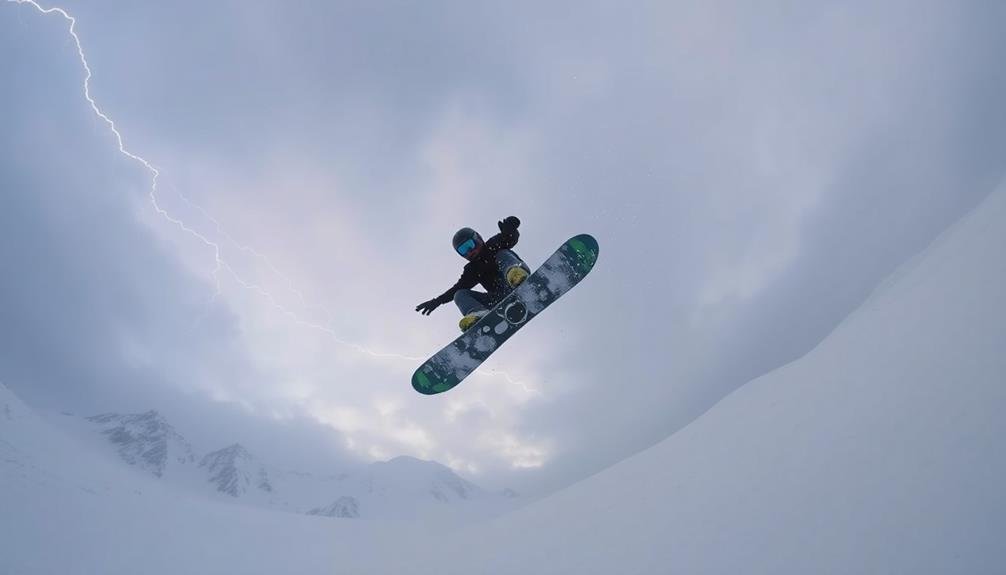
When capturing extreme sports footage, you'll face various weather challenges.
Harsh sunlight can create exposure issues, while wind affects both your drone's stability and audio quality.
You'll need to prepare for sudden rain by rain-proofing your equipment and having backup plans ready.
Harsh Sunlight Challenges
Harsh sunlight poses significant challenges for extreme sports videographers. You'll often face high-contrast scenes that can lead to overexposed highlights or underexposed shadows. To combat this, you'll need to master exposure techniques and use appropriate filters. Consider using a polarizing filter to reduce glare and enhance colors, especially when shooting near water or snow.
When dealing with harsh sunlight, keep these visual elements in mind:
- Sun flares creating dramatic lens effects
- Long shadows stretching across the terrain
- Sweat glistening on athletes' skin
- Bright reflections off equipment and surfaces
- Squinting athletes struggling to see clearly
To mitigate these challenges, plan your shoots around the golden hours of early morning or late afternoon when possible. If you must shoot during midday, look for shaded areas or create your own using diffusers or natural obstacles.
Adjust your camera settings to compensate for the bright light, using a faster shutter speed and lower ISO. Don't forget to protect yourself and your equipment from the sun's intensity. Wear sunscreen, stay hydrated, and use lens hoods to prevent unwanted flare.
With these techniques, you'll capture stunning extreme sports footage even in the harshest sunlight.
Wind and Audio Quality
Howling gusts and whistling breezes can wreak havoc on your audio quality when capturing extreme sports footage. Wind noise can overpower essential sounds like athlete instructions, equipment movements, and environmental ambiance.
To combat this, invest in a high-quality windscreen or "dead cat" for your microphone. These fuzzy covers effectively reduce wind interference without muffling important audio.
Position yourself strategically to minimize wind exposure. Use natural barriers like rocks or trees to shield your equipment. If possible, set up your gear downwind from the action.
For handheld shots, use your body as a wind barrier by positioning yourself between the wind source and your microphone.
Consider using lavalier microphones for interviews or close-up athlete footage. These small, clip-on mics can be tucked under clothing, providing better protection from wind.
For extreme conditions, opt for a shotgun microphone with a specialized wind protection system.
Don't forget to monitor your audio levels constantly. Wind can cause sudden spikes in volume, potentially distorting your recording. Adjust your levels accordingly and be prepared to make quick changes as weather conditions shift.
Rain-Proofing Your Gear
Extreme sports often take place in unpredictable weather, so you'll need to gear up for potential downpours. Invest in high-quality waterproof cases for your cameras and other electronic equipment. These cases should be sturdy and have tight seals to prevent any water from seeping in. For added protection, use silica gel packets inside the cases to absorb moisture.
When filming in rainy conditions, consider using a clear rain cover for your camera. This allows you to operate the controls while keeping your gear dry. Don't forget to protect your lenses with waterproof filters or lens hoods to prevent water droplets from obscuring your shots.
To create vivid imagery of rain-proofed gear in action, imagine:
- A camera encased in a transparent, form-fitting rain cover
- Water beading off a rubberized, weather-sealed camera body
- A drone with waterproof propellers slicing through rain-filled air
- An action camera mounted on a surfboard, submerging and resurfacing
- A filmmaker adjusting settings through a clear plastic sleeve
Remember to wipe down your equipment after each use in wet conditions and allow it to dry completely before storing. By taking these precautions, you'll guarantee your gear stays protected and functional, even in challenging weather.
Framing Dynamic Movements

When capturing extreme sports footage, framing dynamic movements is essential to conveying the excitement and energy of the action. To achieve this, you'll need to master anticipation and composition. Start by studying the sport you're filming to understand its typical movements and patterns. This knowledge will help you predict where the athlete will be, allowing you to frame the shot accordingly.
Use leading lines to guide the viewer's eye and create a sense of motion. Incorporate the surrounding environment to add context and scale to the athlete's movements. Don't be afraid to experiment with unconventional angles – low shots can emphasize height and speed, while high angles can showcase the terrain.
Consider using a wide-angle lens to capture more of the scene and exaggerate the sense of movement. For fast-paced sports, try panning techniques to follow the action smoothly. Remember to leave enough headroom and lead room in your frame to accommodate sudden movements or direction changes.
Lastly, vary your shot types to maintain visual interest. Mix close-ups of intense facial expressions with wide shots of impressive stunts to create a dynamic and engaging sequence that truly captures the essence of extreme sports.
Following the Action
To effectively follow the action in extreme sports footage, you'll need to anticipate the athlete's movements and position yourself accordingly.
You can enhance your coverage by utilizing wide-angle lenses, which capture more of the scene and allow for dramatic perspectives.
Mastering panning techniques will enable you to smoothly track fast-moving subjects, creating a sense of speed and excitement in your footage.
Anticipate Athlete's Movements
For successful extreme sports videography, anticipating the athlete's movements is essential. You'll need to understand the sport, the athlete's style, and the terrain to predict where the action will unfold. Study the sport's techniques and common maneuvers, and observe the athlete during practice runs to familiarize yourself with their unique approach.
Pay attention to the athlete's body language and positioning. These cues can signal their next move, allowing you to be ready with your camera. Consider the flow of the course or terrain, as it often dictates the athlete's path and potential tricks. By anticipating movements, you'll capture more dynamic shots and reduce the risk of missing key moments.
To help visualize the athlete's movements, imagine:
- A snowboarder compressing before a big jump
- A skateboarder's slight shoulder turn before a flip
- A surfer's quick glance at an approaching wave
- A mountain biker's body position shift before a sharp turn
- A rock climber's hand placement telegraphing their next move
Practice tracking shots and panning techniques to smoothly follow the athlete's anticipated path. With experience, you'll develop an instinct for predicting movements, resulting in more compelling and immersive extreme sports footage.
Utilize Wide-Angle Lenses
Wide-angle lenses are essential tools for capturing the full scope of extreme sports action. They allow you to fit more of the scene into your frame, ensuring you don't miss any vital moments. When shooting fast-paced sports like skateboarding or surfing, a wide-angle lens helps you maintain focus on the athlete while including the surrounding environment for context.
Opt for lenses with focal lengths between 14-35mm for full-frame cameras or 10-24mm for crop sensors. These ranges provide enough width to capture expansive landscapes and dynamic movements without excessive distortion. You'll be able to get closer to the action while still maintaining a broad field of view, creating a sense of immersion for viewers.
Remember to experiment with different angles and perspectives. Low-angle shots can make athletes appear larger than life, while overhead views can showcase intricate maneuvers. Don't be afraid to get creative with your compositions – wide-angle lenses allow for unique framing opportunities that can add visual interest to your footage.
When using wide-angle lenses, be mindful of distortion at the edges of the frame. While this effect can sometimes enhance the dynamic feel of extreme sports, it may also detract from the overall image quality if not used intentionally.
Master Panning Techniques
Panning techniques are key to capturing fluid, dynamic footage in extreme sports. To master panning, you'll need to practice smooth, controlled camera movements that follow the action.
Start by setting your camera's shutter speed slower than usual, typically between 1/15 and 1/60 of a second, depending on the sport's speed.
As you pan, keep your subject in the same position within the frame. This creates a sharp subject against a motion-blurred background, emphasizing speed and movement. Use a tripod or monopod for stability, and pivot from your hips rather than your arms for smoother motion.
When panning, visualize these elements to enhance your technique:
- A surfer carving across a wave, spray trailing behind
- A snowboarder slicing through powder, snow flying
- A skateboarder grinding a rail, sparks visible
- A mountain biker maneuvering a tight turn on a dusty trail
- A BMX rider soaring through the air, bike slightly tilted
Practice panning with slower-moving subjects before attempting high-speed action.
Remember to anticipate your subject's movement and start panning before they enter the frame. With consistent practice, you'll soon be capturing professional-looking, dynamic extreme sports footage.
Safety Precautions

Safety should be at the top of your priority list when capturing extreme sports footage. Always assess the environment and potential risks before setting up your equipment. Wear appropriate protective gear, including helmets and padding, especially if you're getting close to the action. Stay alert and maintain a safe distance from athletes and obstacles.
Familiarize yourself with the sport you're filming and its specific safety protocols. Communicate clearly with athletes and event organizers to understand their planned routes and movements. This knowledge will help you anticipate action and avoid dangerous situations.
| Safety Gear | Purpose | When to Use |
|---|---|---|
| Helmet | Head protection | Always |
| Safety harness | Fall prevention | Elevated positions |
| Waterproof casing | Equipment protection | Water sports |
Don't compromise your safety or that of others for the sake of a shot. Use stabilizers and remote-controlled devices to capture footage from challenging angles without putting yourself at risk. If you're filming in remote locations, bring a first aid kit and communication devices. Always have an emergency plan in place and know the nearest medical facilities. Remember, no shot is worth risking your life or well-being.
Post-Processing for Dramatic Effect
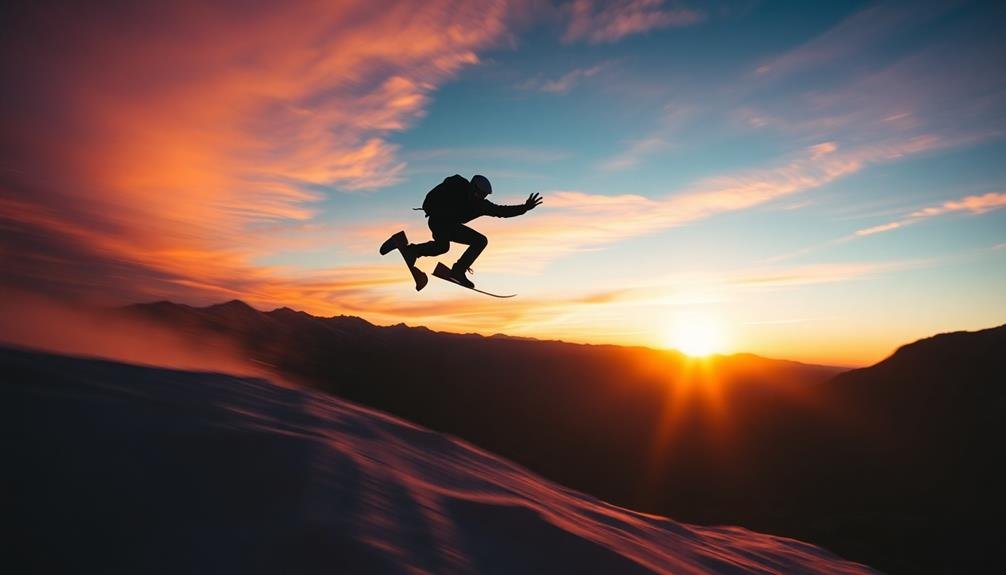
Once you've captured your footage safely, it's time to enhance its impact through post-processing.
Begin by importing your raw footage into your preferred editing software. Trim unnecessary segments and arrange your clips to create a compelling narrative flow. Adjust color grading to emphasize the mood and atmosphere of the extreme sport you've filmed.
Consider these post-processing techniques to add dramatic effect:
- Slow motion: Highlight intense moments by reducing playback speed
- Speed ramping: Alternate between slow and fast motion for dynamic shifts
- Lens flares: Add artificial light streaks to enhance the sun's presence
- Color vignettes: Darken frame edges to draw focus to the action
- Motion blur: Increase blur on fast-moving objects for a sense of speed
Apply subtle sound design to complement your visuals. Layer in ambient noise, impact sounds, and a fitting soundtrack to elevate the viewing experience.
Don't overdo effects; instead, aim for a balance that enhances the raw energy of the sport without appearing artificial.
Legal Requirements for Drone Use
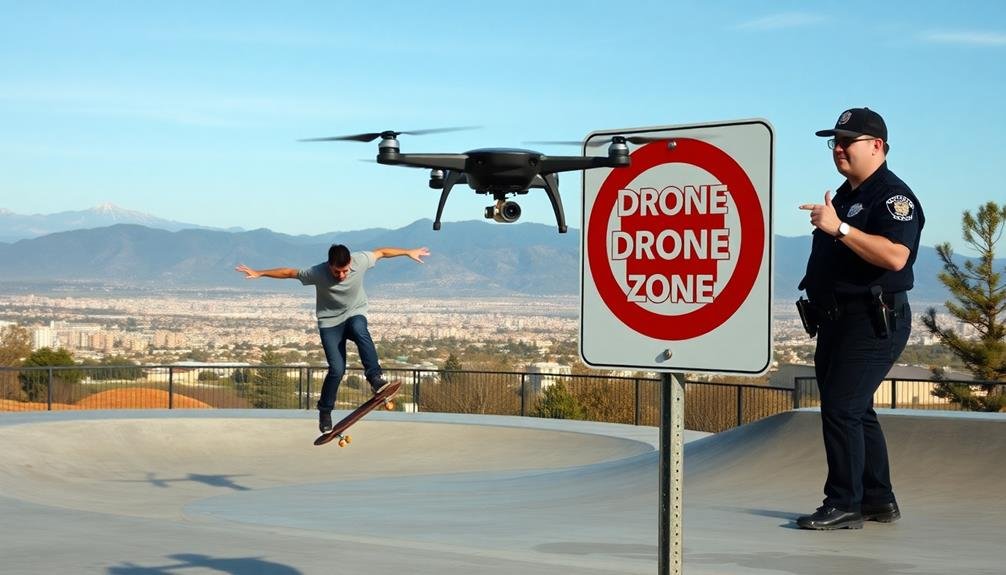
Understanding drone regulations is essential before taking flight for your extreme sports footage. You'll need to register your drone with the FAA if it weighs over 0.55 pounds. Familiarize yourself with airspace restrictions and always fly below 400 feet. Keep your drone within visual line of sight and avoid flying over people or moving vehicles.
Obtain proper certifications, such as the Part 107 license for commercial use. Stay updated on local laws, as they may impose additional restrictions. Always prioritize safety and respect privacy when capturing footage.
Here's a quick reference guide for drone regulations:
| Requirement | Description |
|---|---|
| Registration | Required for drones >0.55 lbs |
| Max Altitude | 400 feet above ground level |
| Airspace | Check for restrictions |
| Certification | Part 107 for commercial use |
Collaborating With Athletes

With your drone skills and legal knowledge in check, it's time to focus on the human element of extreme sports footage. Collaborating with athletes is essential for capturing authentic, compelling content. Start by building relationships with local extreme sports communities. Attend events, join online forums, and engage with athletes on social media to establish connections.
When you've found willing participants, communicate your vision clearly. Discuss the types of shots you're aiming for and listen to the athletes' ideas. They know their sport best and can suggest unique angles or moments to capture. Safety should be your top priority; never ask athletes to perform stunts beyond their skill level for the sake of footage.
To create impactful visuals, consider these elements:
- The athlete's facial expressions during intense moments
- The interaction between the athlete and their environment
- The buildup and anticipation before a big trick
- The graceful or explosive movements mid-action
- The triumphant or disappointed reactions post-performance
Equipment Maintenance and Care
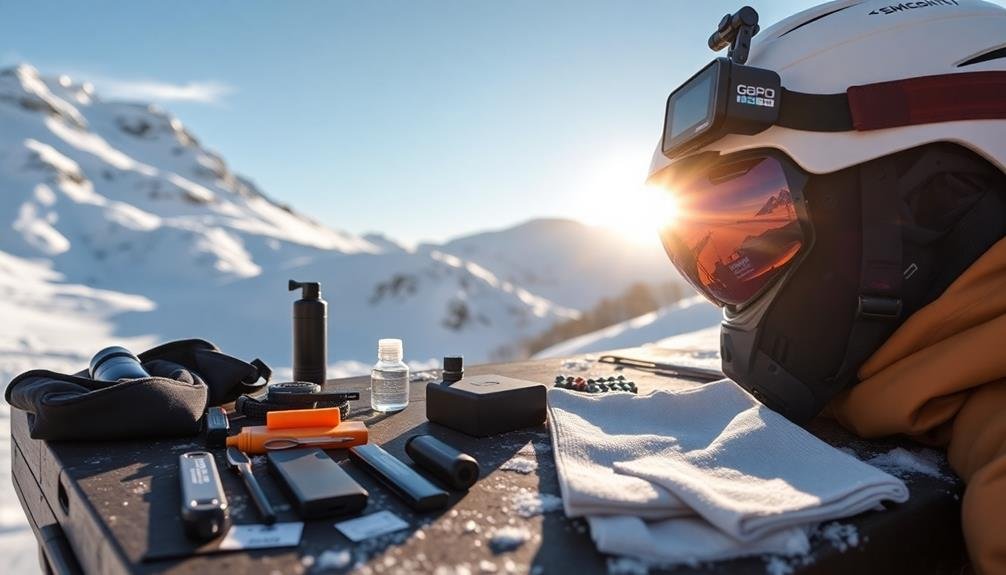
Proper equipment maintenance and care are essential for successful extreme sports filming. Your gear needs to withstand harsh conditions and perform flawlessly when you need it most.
Clean your cameras, lenses, and accessories after each shoot, especially if exposed to sand, saltwater, or dust. Use lens cloths and cleaning solutions specifically designed for camera equipment.
Regularly inspect your gear for signs of wear or damage. Check seals on waterproof housings, replace batteries, and update firmware.
Store your equipment in a dry, temperature-controlled environment when not in use. Invest in quality cases and bags to protect your gear during transport.
Don't forget about your drones and stabilizers. Clean propellers, check for loose screws, and calibrate sensors regularly. Keep spare parts on hand for quick repairs in the field.
Maintain your personal protective equipment too. Check harnesses, helmets, and safety gear for wear and tear. Replace items that show signs of damage or degradation.
Frequently Asked Questions
How Do I Synchronize Multiple Cameras for Multi-Angle Extreme Sports Footage?
To sync multiple cameras for multi-angle extreme sports footage, use timecode generators, synchronization software, or a visual/audio cue like a clap board. You'll need to align the footage during post-production using video editing software's multi-cam features.
What Insurance Options Are Available for Extreme Sports Videography Equipment?
You'll want to contemplate specialized equipment insurance for extreme sports videography. Look into policies covering accidental damage, theft, and water damage. Don't forget to check if your policy includes worldwide coverage for international shoots.
How Can I Minimize Lens Fogging When Filming in Diverse Environments?
To minimize lens fogging, use anti-fog wipes or sprays on your lens. Keep your gear at ambient temperature, use a lens hood, and carry silica gel packets. You can also try a UV filter or dehumidifier for extra protection.
What Are the Best Practices for Capturing Audio in Extreme Sports Videos?
To capture great audio in extreme sports videos, you'll want to use wind protection, invest in quality wireless mics, and position them strategically. Don't forget to record ambient sounds. Always monitor audio levels and have backup recording options.
How Do I Network and Build a Portfolio in the Extreme Sports Videography Industry?
To network and build your portfolio, attend extreme sports events, connect with athletes and brands on social media, collaborate with other videographers, and create a stunning website to showcase your work. Don't forget to join industry-specific online communities.
In Summary
You've now got the tools to capture breathtaking extreme sports footage with your drone. Remember, practice makes perfect. Keep honing your skills, experimenting with angles, and pushing your creative boundaries. Stay safe, respect the athletes, and always follow local regulations. With dedication and the right techniques, you'll soon be producing jaw-dropping action shots that'll make your viewers feel like they're right in the middle of the adrenaline-pumping action. Get out there and start shooting!

As educators and advocates for responsible drone use, we’re committed to sharing our knowledge and expertise with aspiring aerial photographers.
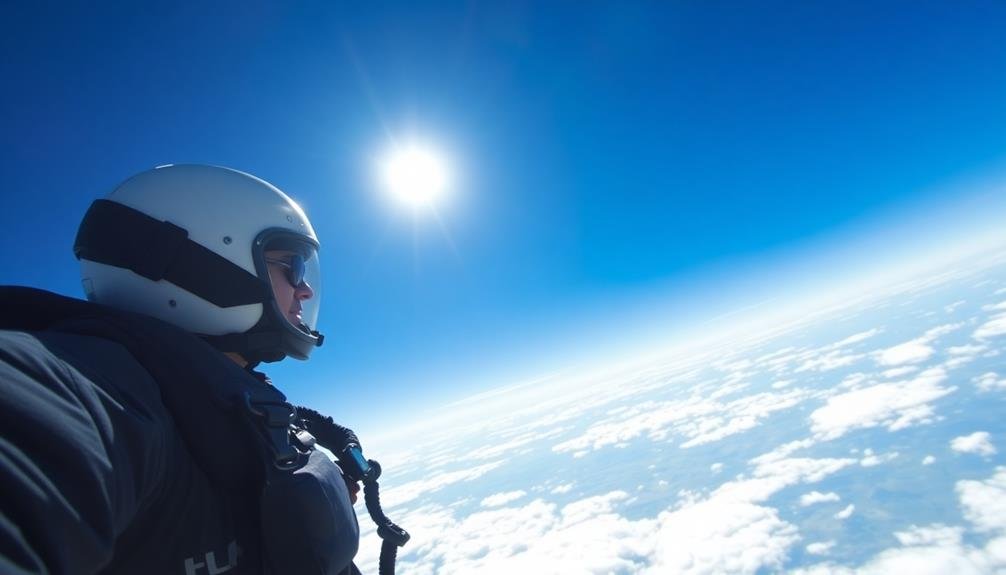



Leave a Reply